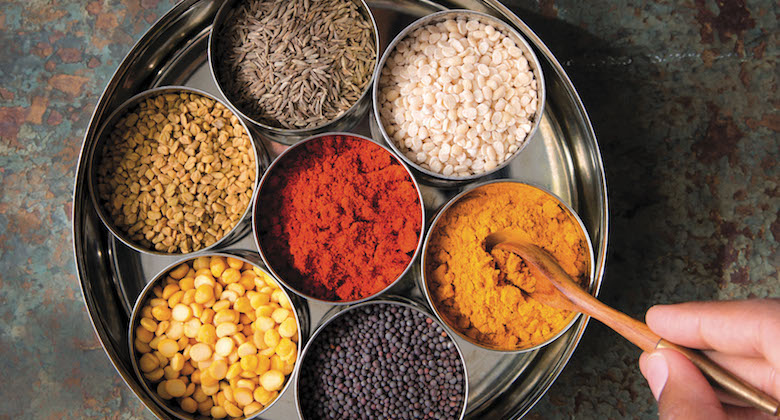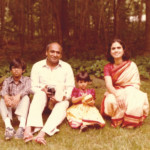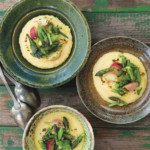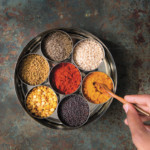
When Chitra Agrawal first prepared lentil stew (sambar) with roasted butternut squash puree from her Crown Heights’ CSA share rather than with chunks of yellow pumpkin as is usual in South India, her mother was skeptical. Today, Agrawal considers it one of her most successful recipes, not only because it stayed true to the flavors of a traditional sambar while adding a rich sweetness but also because it wowed her toughest critic. “When [my mother] tried it, she said, ‘This is good. I’ve never had anything like this!’” says Agrawal.
In her first book Vibrant India: Fresh Vegetarian Recipes from Bangalore to Brooklyn, Agrawal—best known as founder of Brooklyn Delhi, an award-winning small-batch Indian condiments line—takes readers to her mother’s hometown of Bangalore and back to Brooklyn, where she reinterprets her family’s vegetarian recipes, often using local and seasonal ingredients.
Agrawal first learned to cook her ancestral cuisine at her parents’ side, but she developed and honed her modern, mash-up approach to food on her blog, “ABCD’s of Cooking,” in 2009. Her blog, whose name is an acronym for “American Born Confused Desi” (a term sometimes used to describe a South Asian person born and raised in the States), grew in popularity, and soon she was conducting private cooking classes, catering and writing about food. By 2013, Agrawal had quit her day job in marketing, launched Brooklyn Delhi and started developing recipes for what would eventually become Vibrant India.
The recipes in her debut cookbook draw specifically from the author’s Hoysala Karnataka Hindu Brahmin roots; this particular South Indian vegetarian sub-cuisine comprises seasonal vegetables and fruits and unprocessed whole grains, nuts, seeds, oils and dairy, all said to be foods acceptable for offering to Hindu gods. Agrawal believes it’s an exciting time to be cooking Indian food for Western consumers. “There’s a move away from familiar ‘Indian’ restaurant foods—North Indian curries and naan and such—and a surging interest in and appreciation for India’s many regional cuisines.”
Her guiding principle has always been accessibility and familiarity, however, whether on her blog or in her book. “I would love for a lot more people to know about this style of cooking,” she says. “These are highly adaptable recipes once you understand the basic techniques and key flavor profiles.” In Vibrant India, Agrawal encourages home cooks to experiment and offers ingredient substitutions and serving suggestions. The butternut squash in her aforementioned stew recipe, for example, can be replaced with roasted kabocha or delicata instead. Agrawal suggests that readers serve adai, a rice-and-lentil crepe commonly served for breakfast in South Indian homes, with sautéed seasonal vegetables, hard-boiled eggs or hummus, plain yogurt and Agrawal’s own Brooklyn Delhi achaar (pickle).

Elsewhere in the book, Agrawal’s recipes borrow from even wider culinary influences. “Ben’s Curry Leaf Popcorn,” homemade popcorn tempered with black mustard seeds, asafetida, curry leaves and red chilies in oil, is one of her Midwestern husband’s contributions. “Lettuce ‘Dosa’ Wrap with Curried Potato and Chutney,” a butter lettuce leaf topped with traditional masala dosa potato filling and cilantro-and-coconut chutney, is a nod to her popular Indian/Chinese pop-up dinner series, Tangra, with cookbook author Diana Kuan.
Agrawal insists that her book is not a complete canon of South Indian cooking. “I like to have fun,” she says. “And so should the home cook. I love to stick close to traditional flavors and techniques but readily adapt [recipes] to the ingredients I have on hand.” She also rejects the notion of “authenticity” when it comes to the home kitchen. When trying to codify her family’s sambar powder, a red chili-based spice blend, Agrawal learned that each cook in her family had a slightly different recipe. “Learn from my interpretations and build on them further to make the recipes your own,” she says.
Vibrant India hits stands on March 21, 2017. Pre-order your copy here.
Photos reprinted with permission from Vibrant India: Fresh Vegetarian Recipes from Bangalore to Brooklyn by Chitra Agrawal, copyright © 2017. Published by Ten Speed Press, an imprint of Penguin Random House LLC.
Photography credit:
Food photos Erin Scott © 2017
Location photo Ben Garthus © 2017






